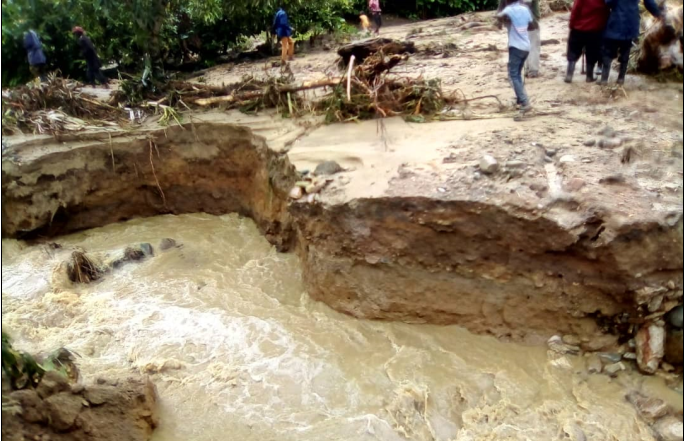Prime
Floods leave death, despair countrywide

This photo taken on September 3, 2022 shows River Ntotoro which flooded following overnight downpour in Bundibugyo District on September 2, 2022. PHOTO/LONGINO MUHINDO
What you need to know:
- A mini-survey carried out by Daily Monitor on flood-hit areas across the country highlights environmental degradation and inadequate physical planning compliance as the key causes of a disaster that has claimed lives and brought misery to several families.
Hundreds of families are homeless after being displaced by the deadly floods that have left a trail of destruction across the country.
The floods resulting from the heavy rain have reportedly claimed the lives of at least 31 people – 29 from Mbale City and two in Bundibugyo District.

This photo taken on September 3, 2022 shows River Ntotoro which flooded following overnight downpour in Bundibugyo District on September 2, 2022. PHOTO/LONGINO MUHINDO
They have also destroyed crops, houses and other property worth millions of shillings since August.
Survivors in the affected areas say they are unsure how to rebuild their lives after losing their savings and, in many cases, loved ones.
Mbale
In Mbale, the floods were triggered after several rivers such as Nabuyonga, Namatala, Nashibiso and Napwoli burst their banks.
According to a comprehensive report from the Office of the Prime Minister (OPM), about 1,000 persons were displaced, 80 houses and three health centres damaged by floods in Mbale City in August.
The floods also washed away bridges on roads such as Mbale-Bufumbo, Namabale, Nashikasho, Namawane, Nagairrira, Busamaga, Bukhatoko, Ndohwe, Nambitsi, Namakole, and Nabuyonga.
The other affected roads were Mbale- Nkokonjeru, Mbale-Bufumbo roads, Nashikasho–Namawane, Sakiya–Bukhatoko, Ndohwe, Nambitsi, Busaano, and Busaano-Bufoto.
Local leaders partly blamed the floods, the first of its kind in the middle of the city, in recent years to poor physical planning and corruption.
“The physical plan of the city has been mismanaged and builders have erected houses where water was supposed to pass,” Mr John Maango Situma, an elder, said.
Mr Situma, who is also a historical member of the Elgon 13 battalion that fought during National Resistance Army war in 1986, said during the old days, the area never experienced floods because the construction of buildings was done in line with urban authority’s laws and regulations.
“Leaders should stop issuing permits, land titles and house plans to be constructed on water ways because when the rivers flood, water takes its course and along the way, many people will be affected,” he said.

Boda bodas use the Manibe-Terego-Yumbe road that is in a sorry state on September 4, 2022. The road connects to Arua City. PHOTO/ FELIX WAROM OKELLO
Mr Juma Mugabi, a retired civil engineer, said the city leadership should restore the environment to save people from natural disasters.
“People must leave wetlands and river banks. They must build only with an approved plan,” he said.
The State minister for East African Community, Mr James Magode Ikuya, said: “Mbale City is now getting poorly planned. It was a purely well planned city, the best in East Africa and that is worrying. All those in position of making decisions must reflect and address the situation.”
Mr Yasiin Mafabi, an opinion leader, said due to bribes, developments are taking place in wetlands.
“I struggle to make sense of the type of leadership we have these days. All they want is money,” he said.
Mr David Mbogo, an environmentalist, asked city authorities to enforce planning. “The so-called developers just build anywhere. We now have schools in wetlands,” Mr Mbogo said.

Pedestrians and boda bodas manoeuvre through the sides of a flooded Yumbe-Bididi base camp road in Yumbe District on September 5, 2022. PHOTO/ ROBERT ELEMA.
However, the Mbale City Council spokesperson, Mr James Kutosi, said the city is well planned.
“You cannot link floods to planning. Even in developed countries such as the US, Germany, it floods. Floods occur everywhere, not only in Mbale,” Mr Kutosi said.
But the Mbale City environment officer, Ms Rhoda Nyaribi, said encroachment on river banks through settlement and farming activities can lead to flooding.
“The flash floods are because of a lot of degradation,” she said.
Ms Nyaribi said people need to move away from river banks so that the ecosystem is restored and preserved.
Amuru
In Amuru District, leaders are bracing for floods in the border town of Elegu after the Uganda National Meteorological Authority (UNMA) issued an alert last month indicating that there would be rising water levels in the neighbouring Ayugi and Unyama rivers due to heavy rain experienced in Gulu, Omoro, Nwoya and Amuru.
Mr Michael Lakony, the chairperson of Amuru, said locals are being sensitised on how to survive if the disaster strikes.
UNMA warns that River Unyama, which is near the Elegu Border post at the Uganda-South Sudan border, may burst its banks due to above-normal rainfall expected this month and October.
In its seasonal rainfall outlook published on Friday, UNMA projects that the months of September and October will be wetter than November and December.
In Kisoro, property worth millions of shillings was on Friday destroyed by a downpour in Rubuguri Town Council.
The most affected villages are Kashija, Rushaga, Birara, and Musezero. The tourism roads that became impassable include Rubuguri-Muko, Rubuguri-Nteko, and Rubuguri-Kisoro Town.
The chairperson for Rubuguri Town Council, Mr Nicholas Hakiiza, said the evening downpour that lasted for about three hours left 10 houses destroyed. The disaster did not spare crops either.
“We thank God that no life was lost during this downpour although properties were destroyed,’’ Mr Hakiiza said, while appealing to humanitarian organisations to support more than 200 individuals who have been hit by the disaster.
In Kwania District, residents of more than 10 villages in Aduku Sub-county and Aduku Town Council are counting losses after flash floods destroyed homes.
The affected villages are Olekke, Akot ‘A’ and Akot ‘B’ in Alira Parish, Odeo Corner, Odeo Bung, Amia ‘A’, Alebe, and Aruma villages in Aboko Parish and Ot-Ogole Cell in Aduku Town Council.
Local leaders said the floods submerged several gardens of crops, access roads and some buildings.
Mr Godfrey Ongom, a resident of Amia Village, one of the affected persons, said water submerged his home and gardens.
“The road contractors built the road, but didn’t open any culvert, so when it rains, water collects at one side and finds its way to peoples gardens and homes,” he said.
Mr James Alele Lubega, the chairperson of Aboko Parish in Aduku Sub-county, said many residents have been cut off by floods.
“There are two villages here where the roads are cut off. People are unable to access social services,” he said.
Mr Jimmy Uhuru, the chairperson of Aduku Township Cell in Aduku Town Council, said: “My gardens in Ot-Ogole Cell are now submerged. Many people are facing the same problem. Some homes are also submerged.”

A motorist drives past a broken bridge on a road in Ajugopi Parish that connects to Pakele and Pachara sub-counties in Adjumani District on September 6, 2022. PHOTO/SCOVIN ICETA
Mr Tonny Ojok, the speaker of Aduku Sub-county, said: “We had a prolonged dry spell which affected food production. So, this has left people with a lot of problems within the community.”
Mr Francis Opolot, the Kwania Chief Administrative Office, said his office is yet to collect the data of the affected persons. “I was out of office, but when I get back, I will collect the data of the victims and forward it to the disaster management team,” he said.
Bundibugyo
In Bundibugyo, the Sunday morning floods washed away five bridges on rivers Nyakighoma, Ntotoro, Ngomekome, Mbule, and Nyabughesera in the sub-counties of Mabere, Ngamba, Ntandi and Ntotoro.
The floods also left two people dead, according to local authorities.
In Teso Sub-region, most of the roads are likely to be cut off following the ongoing heavy rains being experienced after a prolonged dry spell, the Katakwi chairperson, Mr Geoffrey Omolo, said.
“Our worry is that the bridges could easily give way as water in the swampy areas continues to rise,” he said on Tuesday.
In West Nile, more than 1,200 residents have been displaced by floods in Adjumani District.
The floods affected villages of Ogolo North and Ogolo South in Liri Parish, and Elegu Central and Melekwe in Elegu Parish in Arinyapi Sub-county after River Tete burst its banks.
Mr Dominic Seseseko, the chairperson of Arinyapi Sub-county, said more than 500 acres of crops; rice, sorghum, cassava, simsim, sweet potatoes and beans have been destroyed.
Mr Justine Amizaru Luga, one of the affected farmers, said: “I spent a lot of money to plant, but I don’t know if I will harvest anything.”
The chairperson of Adjumani District, Mr Ben Anyama, said a team of disaster management committee is carrying out an assessment of the impact of the floods before reporting to the Office of the Prime Minister.
Earlier this month, close to 25,000 refugees from Alere and Oliji refugee settlements in Pachara Sub-county faced difficulties in accessing social services due to a downpour that swept away Oliji bridge.
In Pakwach, floods last week left several passengers stranded after River Tangi burst its banks cutting off Pakwach-Olwiyo-Karuma road for over nine hours. No death cases were reported.
The Koboko focal person for district disaster management committee, Mr Tom Odama, said they have registered 900 victims of disaster from the sub-counties of Lobule, Abuku Ludara and Kuluba.
“We have continued to sensitise the people about the dangers of settling closure to the river banks. The district council has resolved to set aside two percent of the budget from all departments to cater for disaster management,” he said.
Mr Jeconius Musingwire, an officer working with the National Environmental Authority in south western, said locals have degraded the environment, which has left them prone to disaster.
“The only option is putting soil and water conservation structures (ditches) so that water is maintained in the soil to stop surface runoff,” he said.
See related story on Page 32
Compiled by Bill Oketch, Tobbias Owilly, Santo Ojok, Yahudu Kitunzi, Fred Wambede, Simon Peter Emwamu, Robert Muhereza, Leonard Mbishinzimana, Alex Ashaba, Longino Muhindo,Taibot Marko, Felix Warom Okello, Clement Aluma, Ronald Acema, Fredrick Anyine & Felix Ainebyoona



